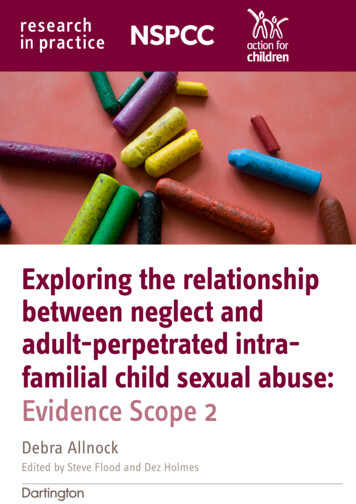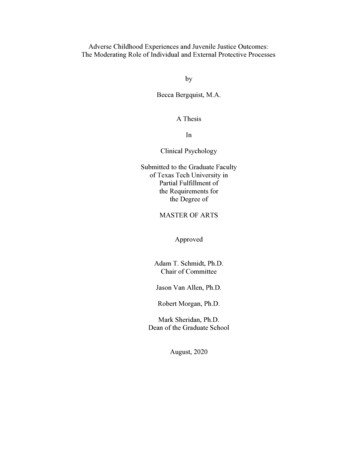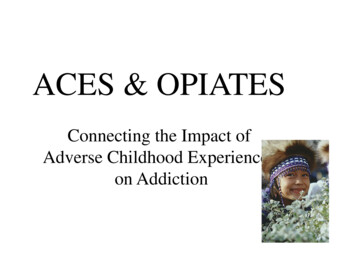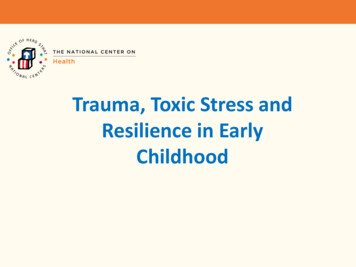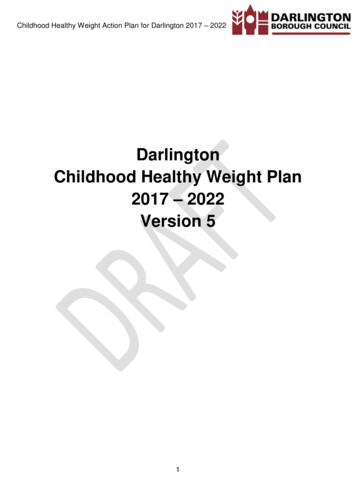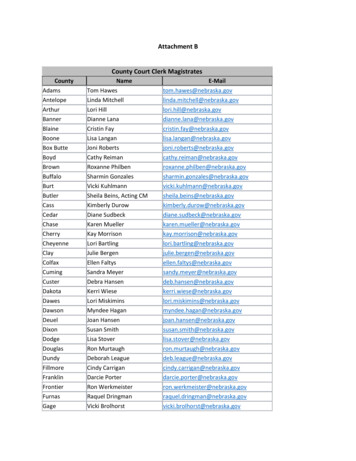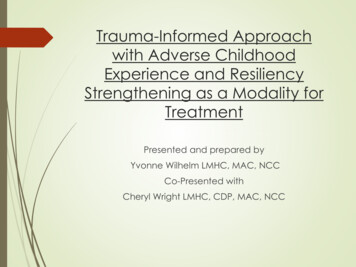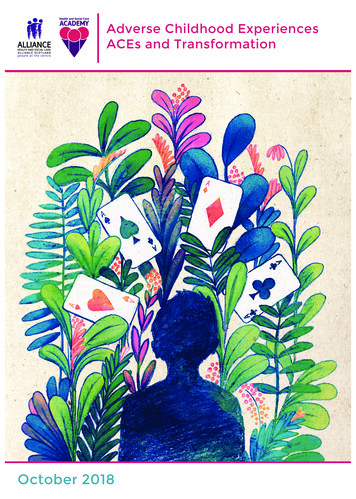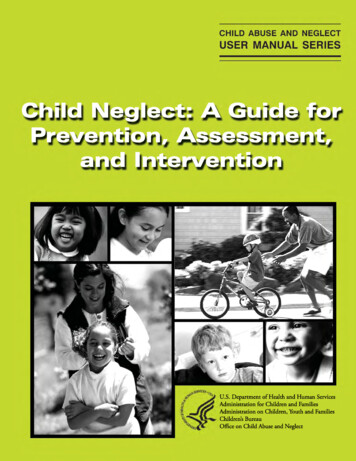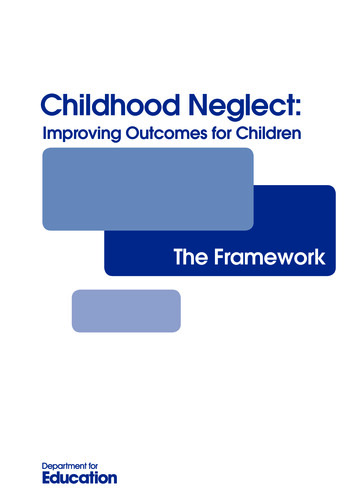
Transcription
Childhood Neglect:Improving Outcomes for ChildrenThe Framework
The FrameworkContentsThis framework is to be used to plan anddevelop training courses. Please refer to theTraining Guidance document for furtherdetails on how courses should be developed.The FrameworkAssessment and service provision3Overcoming practice and organisational barriers 4Supporting materialsEvans family case study5Henderson/Miller/Taylor family case study6Ahktar family case study7Additional audio-visual resources8Working practice scenarios8Printable handouts92
Childhood Neglect: Improving Outcomes for ChildrenAssessment and Service ProvisionRecognition and ResponseLearning OutcomesRecognise signs and symptoms of children and young people who are, or may be, neglectedIdentify concerns about parenting capacity that may contribute to neglectIdentify family and environmental factors which may contribute to neglectUnderstand that child development is a dynamic process shaped by historical and currentinteractions between child, family and environmentPresentationsCoreP1 Understanding neglectP2 Identifying when parenting capacity is resultingin neglectP3 Identifying family and environmental factors whichmay contribute to neglectPresentationsP4 Child’s health, including mental healthP5 Neglect and young peopleP6 Disabled childrenP7 Parenting and domestic violenceP8 Parenting and substance misuseP9 Parenting with learning disabilitiesP10 Parenting with mental health difficultiesFurtherExercisesExercisesLearning OutcomesAssessment, Analysis and PlanningE1 Understanding neglectE2 Noticing neglectE3 Identifying concerns about parenting capacitywhich affect the child and their needsE4 Assessing family and environmental factors whichaffect the child and parenting capacityE5 Recognising the impact of neglect on childrenand young peopleE6 Neglect and attachmentE7 Neglect and unmet health needsE8 Understanding factors affecting parental empathyE9 Impact of substance misuse on parenting capacityE10 Impact of learning disabilities on parenting capacityE11 Impact of neglect on educational achievementAssess the nature and extent of a child’s developmental needsAssess parents’ capacity to respond to the child’s needsAssess family and environmental factors that may affect a child and parenting capacityDevelop relationships with child, family members and relevant professionalsPresentationsP11 Assessing children’s developmental needs CoreP12 Assessing parental capacityP13 Understanding family and environmental factorsPresentationsExercisesExercisesE12 Communicating with the childE13 Communicating concerns to parentsE14 Understanding adult substance misuseand dependenceE15 Assessing the child in their communityFurtherP14 Assessing attachmentP15 Communicating with parentsP16 Assessing the role of fathers/ father figuresP17 Understanding the contribution of extended familyP18 Assessing motivation and willingness to changeE16 The child’s perspectiveE17 Assessing adolescent wellbeingE18 Understanding attachment and separationE19 Assessing and planning to meet a childor young person’s needsE20 Assessing impact of substance misuseE21 Engaging parents and carersE22 Analysing the interaction betweenparents and communitiesIntervention and ReviewLearning OutcomesMeet a child’s developmental needs and support strengthsAddress factors affecting parenting capacityAddress family and environmental factorsReview outcomes and measure whether interventions are successfulPresentationsP19 Effective interventions in neglect casesP20 The role of schoolsP21 Measuring outcomes for each childExercisesCoreE23 Keeping the child at the centreE24 Ensuring a child’s needs are metE25 Working directly with a child or young personE26 Reviewing and sustaining changeE27 Connecting the child and family with communitiesPresentationsFurtherP22 Working with looked after childrenP23 Working effectively with substance misusing parentsP24 Working with parents with learning disabilitiesExercisesE28 Outcomes or indicators?E29 Promoting resilienceE30 Improving parenting capacityE31 Reviewing pace of changeE32 Addressing housing needs
Childhood Neglect: Improving Outcomes for ChildrenOvercoming Practice and Organisational BarriersRecognition and ResponseLearning OutcomesUnderstand personal values in relation to neglectUnderstand barriers to recognition and response of sesExercisesP25 Understanding neglect and social valuesP26 Understanding barriers to recognition and responseE36 Exploring your valuesE37 Thinking about whether you have been worriedabout a childE33 Considering your views of neglectE34 Considering public perceptionE35 Taking concerns seriouslyAssessment, Analysis and PlanningLearning OutcomesOvercome factors that impede assessment, analysis and planningUnderstand importance of looking beyond single incidents (cumulative sExercisesP27 Understanding assessment and decision-makingP28 Understanding cumulative harmE41 The emotional impact of talking about childrenand familiesE42 Working with children, parents and familiesE43 Planning to meet carers needsE38 Thinking about your assumptionsE39 Guarding against biasE40 Taking account of historical informationIntervention and ReviewLearning OutcomesUnderstand what hinders and facilitates integrated workingMaintain the momentum of esExercisesP29 Understanding integrated workingE44 Promoting and maintaining meaningful changeP30 Child neglect and supervisionE45 Working together in a sustained way to help theyoung personE46 The language of services4
Supporting materialsFamily Case StudyEvansAudio-visual resourcesM1.1 Fiona Evans’ storyFiona is the mother of the three children, white and 38 years old. She sharesher experience of growing up in care and how this impacts upon familyrelationships and relationships with agencies.M1.2 Steve Evans’ storySteve is father to the youngest two children, and step-father to Liam. Steve,who is black and 36 years old, describes the struggle of parenting andfamily life from his perspective.M1.3 Liam Evans’ storyLiam is the eldest of three children, white and 15 years old, he is regularlyin trouble with the police and he describes life from his perspective and thedifficult relationship that he is experiencing with his family.M1.4 Shireen Evans’ storyShireen is 10 years old and of dual heritage. She gives an account of herlife as a child who is missing out on activities and social opportunitiesexperienced by her peers. She describes strained relationships anddifference between her experience of family life and the family lives ofothers.M1.5 Lewis Evans’ storyLewis is 8 years old and of dual heritage. He describes life for a child ina chaotic household, where there is limited parental supervision. Heacknowledges the difference between his own home and the homes of hisfriends.Printable versionsF1.0F1.1F1.2F1.3F1.4F1.5F1.6Evans family case studyFiona Evans’ storySteve Evans’ storyLiam Evans’ storyShireen Evans’ storyLewis Evans’ historyLiam Evans’ history5
Supporting materialsFamily Case StudyHenderson/Miller/TaylorAudio-visual resourcesM2.1 Claire Henderson’s storyClaire is mother to the five children, white and 30 years old. Claire has somelearning disabilities and struggles with her mental health. More recently,her use of drugs and alcohol has increased to levels causing concern. Shedescribes family life from her perspective and the challenges of parenting.M2.2 Darren Miller’s storyDarren is a 45 year old white man who regularly uses drugs and alcohol.He is father to the family’s three youngest children and he describes thefrustrations of family’s life from his perspective.M2.3 Michelle Henderson’s storyMichelle describes her situation as a pregnant teenager, and her hopesfor the future. Michelle’s story touches on her relationships, childhoodexperiences and her current frustrations with health and children’s socialcare.M2.4 Troy Taylor’s storyTroy is a 12 year old white boy. He describes his school and home life, andhis experience of living in a chaotic and unstructured household where he isincreasingly taking on caring responsibilities for his younger siblings.M2.5 Susan Miller’s storySusan is a 6 year old white girl who gives an account of her school andhome life in a chaotic and unstructured household. She describes thephysical symptoms of neglect.Printable son/Miller/Taylor family case studyClaire Henderson’s storyDarren Miller’s storyMichelle Henderson’s storyTroy Taylor’s storySusan Miller’s storyMichelle Henderson’s historyMichelle Henderson’s chronologyTroy Taylor’s history6
Supporting materialsFamily Case StudyAkhtar’sAudio-visual resourcesM3.1 Mabina Akhtar’s storyMabina is an Asian woman in her 30s with one child. She gives an accountof her experience of caring for a toddler whilst her husband works longhours. The house is immaculately clean and tidy, and the family is financiallyaffluent. Mabina cannot understand why the Health Visitor is concernedabout her child’s slow development and lack of opportunities for socialinteraction.M3.2 Saleem Akhtar’s storySaleem is an Asian man who has a successful career that keeps him awayfrom his wife and young son for long hours. He describes his frustration withthe Health Visitor who is suggesting that his son’s slow development is dueto social and emotional isolation. He provides materially for the family, andhe cannot understand why other people are concerned.Printable versionF3.0F3.1F3.2F3.3Akhtar family case studyMabina Akhtar’s storySaleem Akhtar’s storyWasim Akhtar’s chronology7
Supporting materialsAdditional audio-visual resourcesM4.0 Emily’s storyA woman’s account of her life as a neglected child and the impact of neglectinto her adulthoodM4.1 Parents’ statementsThese are recordings of statements made by parents.Working Practice ScenariosMS1.1/MS1.2 - Scenario 1 Head of yearSchool Teacher in discussion with a Head of Year about a neglected youngperson, Liam Evans.MS2.1/MS2.2 - Scenario 2 Specialist Child Protection NurseHealth Visitor in discussion with a Specialist Child Protection Nurse aboutKimberley Miller, a baby who is not meeting her developmental milestones.MS3.1/MS3.2 - Scenario 3 Children’s Social CareHealth Visitor making a telephone referral to Children’s Social Care inrelation to Wasim Akhtar, a toddler that may be experiencing emotional andsocial isolation.MS4.1/MS4.2 - Scenario 4 Social Work ManagerA social worker receiving formal supervision from a social work manager inrelation to the Henderson/Miller/Taylor family where outcomes for childrenare not improving despite a period of social work intervention.MS5.1/MS5.2 - Scenario 5 Legal ServicesA telephone discussion between a social work manager and arepresentative from legal services in relation to the Evans family.8
Supporting materialsHandoutsPrintable HandoutsH1 A language of feelingsH2 Child neglect and supporting workersH3 Guarding against biasH4 Neglect and attachmentH5 Structural factors affecting children and familiesH6 Start with the childH7 The importance of historical informationH8 The motivation to changeH9 Understanding neglect from a parent’s viewH10 Adults who misuse substancesH11 Introduction to definitionsH12 Key facts about domestic abuseH13 Principles of partnershipH14 Process of assessmentH15 Addiction and dependenceH16 Identifying neglect-10 top tips9
Childhood Neglect: Improving Outcomes for Children Assessment and Service Provision Core Core Further Further Core Further . 4 Childhood Neglect: Improving Outcomes for Children Overcoming Practice and Organisational Barriers Exercises E33 Considering your views of neglect . E41 The emotional impact of talking about children and families E42 .
